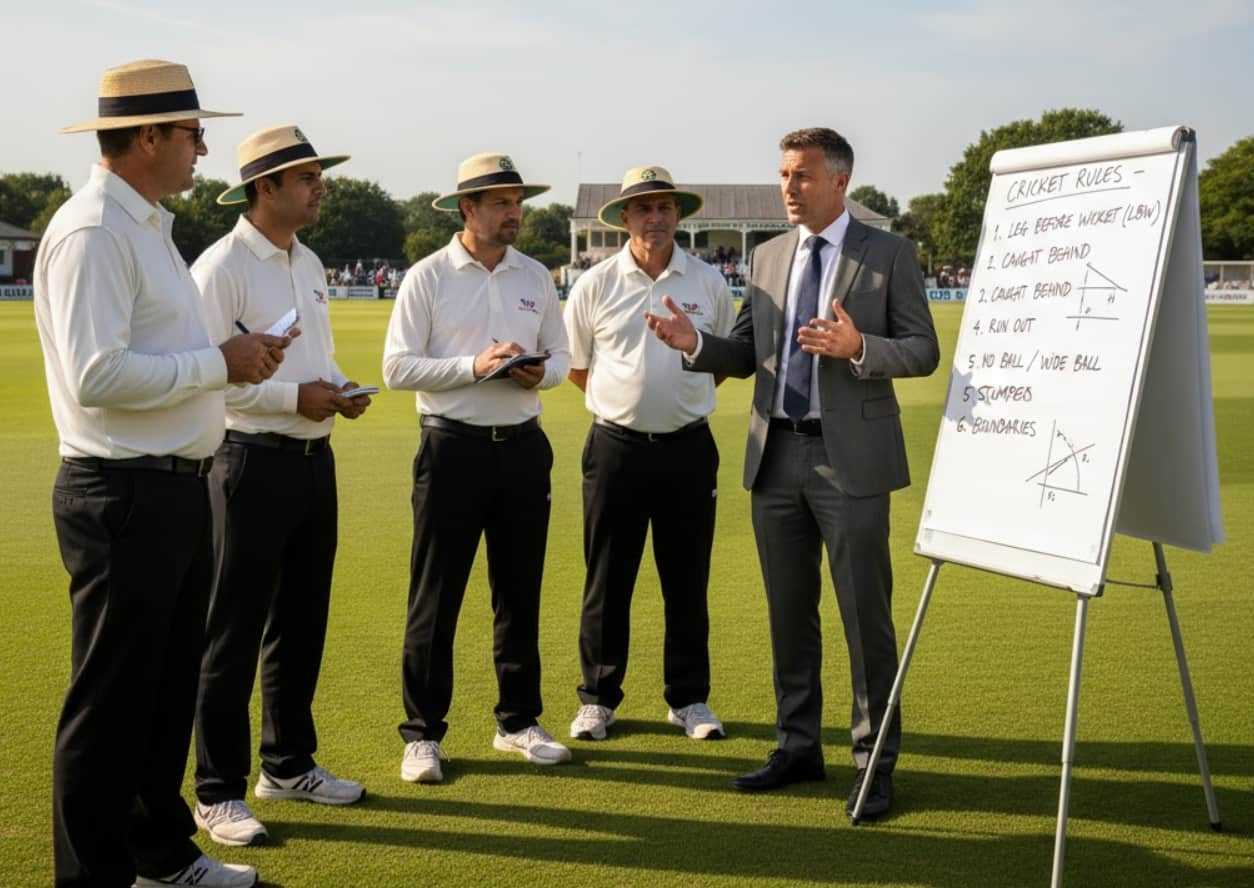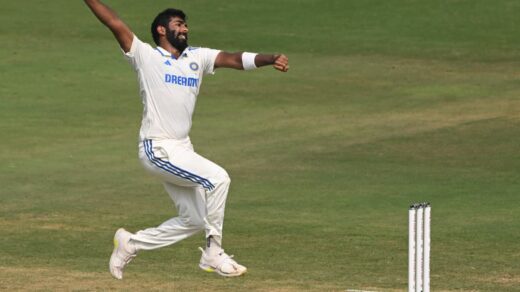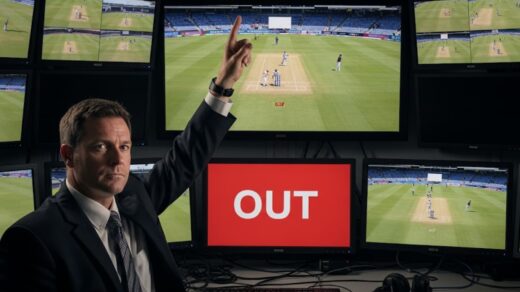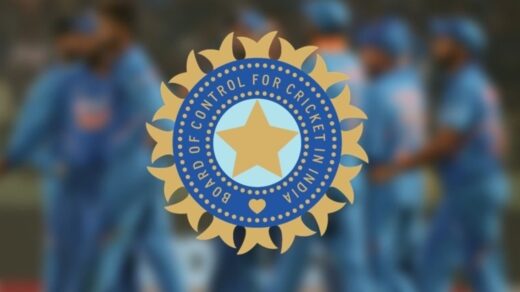Have you ever watched a cricket match and thought, “I could be out there making those crucial decisions”?
Do you love cricket so much that you want to be part of the action, even if it’s not as a player?
If yes, then becoming a cricket umpire might be your perfect path!
Cricket umpires are the guardians of the game. They ensure fair play, make split-second decisions, and keep the spirit of cricket alive.
From signaling boundaries to judging LBWs, umpires are at the heart of every match.
Many cricket lovers dream of becoming umpires in 2025. The good news? It’s totally achievable!
Whether you want to officiate local club matches or dream of standing in IPL or international games, this guide will show you exactly how to become a cricket umpire in 2025.
How to Become a Cricket Umpire in India in 2025?

This article covers everything: the step-by-step process, required courses, salary details, and insider tips to help you succeed.
Think of this as your personal roadmap to an exciting umpiring career.
For more cricket-related updates and umpiring news, visit CricketBureau.com, a professional cricket blog that covers everything about the sport.
What Does a Cricket Umpire Do?
Before diving into how to become a cricket umpire in India, let’s understand what umpires actually do. It’s much more than just raising your finger for an out!
Cricket umpires are like judges on the field. They maintain fairness, apply the laws of cricket correctly, and ensure the game flows smoothly. Every decision they make affects the match outcome.
Key Duties of a Cricket Umpire:
On-Field Responsibilities:
- Making dismissal decisions (out or not out)
- Signaling runs, boundaries, and extras
- Judging LBW appeals
- Calling no-balls and wides
- Monitoring bowlers’ actions for illegal bowling
- Keeping track of overs
- Ensuring fair play between teams
Off-Field Responsibilities:
- Inspecting pitch and ground conditions
- Checking equipment (balls, bails, stumps)
- Reporting match incidents to authorities
- Maintaining match records and reports
- Coordinating with the match referee when needed
Umpire Roles Summary:
| Type of Duty | Examples |
|---|---|
| Decision Making | LBW, catches, run-outs, stumpings |
| Signaling | Boundaries, wides, no-balls, leg byes |
| Match Control | Counting overs, managing time, and weather delays |
| Fair Play | Monitoring player behavior, the spirit of cricket |
| Equipment Check | Ball condition, protective gear, and field setup |
Umpires must stay calm under pressure, be physically fit to stand for hours, and have excellent concentration. It’s challenging but incredibly rewarding!
How to Become a Cricket Umpire in India in 2025?
Step 1 – Learn the Laws of Cricket
The first step in how to become a cricket umpire in 2025 is mastering the laws of cricket. You can’t umpire what you don’t understand!
The MCC Laws of Cricket are your bible as an umpire. These are the official rules that govern cricket worldwide, maintained by the Marylebone Cricket Club (MCC) in London.
How to Learn Cricket Laws:
Download the Laws:
- Visit the official MCC website
- Download the complete laws PDF for free
- It’s available in multiple languages
- Study them section by section
Get the Right Books:
- “Tom Smith’s Cricket Umpiring and Scoring” – This is the ultimate guide for umpires. It explains complex laws in simple language with real-life examples.
- MCC Official Laws Book – The complete rulebook every umpire should own.
- Cricket Law Updates – Laws change occasionally, so stay updated with amendments.
Study Key Sections First:
- Law 16: The Result (how matches are won)
- Law 24: No Ball (understanding illegal deliveries)
- Law 25: Wide Ball (what counts as a wide)
- Law 36: LBW (the most complex and controversial law)
- Law 31: Appeals (how decisions are made)
Practice with Scenarios:
Test yourself with questions like:
- “The ball hits the batsman’s pad outside off stump, but was going to hit the stumps. Out or not out?”
- “A fielder catches the ball, but his foot touches the boundary rope. Is it a catch or six?”
- “The bowler delivers with both feet outside the crease. What do you call?”
Understanding these scenarios prepares you for real match situations.
Pro Tip: Don’t try to memorize everything at once. Focus on common laws first, then gradually learn complex ones. Real match experience will help reinforce your knowledge.
🏫 Step 2 – Join a Cricket Association
To officially become an umpire in India, you must register with a cricket association. This is your entry point into organized cricket umpiring.
How to Join:
Find Your Local Association:
India has cricket associations at different levels:
- District Cricket Associations (your city or district)
- State Cricket Associations (your state)
- All are affiliated with the BCCI (Board of Control for Cricket in India)
Examples of Major Associations:
- Mumbai Cricket Association (MCA)
- Delhi District Cricket Association (DDCA)
- Tamil Nadu Cricket Association (TNCA)
- Karnataka State Cricket Association (KSCA)
- Bengal Cricket Association (BCA)
Registration Process:
- Visit your local association’s office or website
- Fill out the umpire registration form
- Pay the registration fee (usually ₹500-2000)
- Submit required documents:
- Age proof (must be 18+ years)
- Educational certificates
- Passport-size photographs
- Address proof
Why This Matters:
Registration with a cricket association is mandatory because:
- It gives you official recognition as an aspiring umpire
- You become eligible for umpiring courses
- The association provides opportunities to officiate matches
- It’s required for taking the BCCI Level 1 exam
- You get access to networking with experienced umpires
Important: Different states have slightly different processes. Contact your state association directly for specific requirements.
Step 3 – Take the BCCI Level 1 Umpiring Course (2025)
This is the most crucial step in how to become a cricket umpire in India. The BCCI Level 1 Umpiring Course is your official certification to start umpiring organized cricket matches.
What is the BCCI Level 1 Umpiring Course?
Think of it as your umpiring license. Just like you need a driving license to drive, you need this certification to umpire official matches.
BCCI Level 1 Umpiring Course 2025 Details:
| Course Details | Information |
|---|---|
| Course Name | BCCI Level 1 Umpiring Course 2025 |
| Type | Written Exam + Practical Assessment |
| Eligibility | Must be registered with the state cricket association |
| Age Requirement | Minimum 18 years |
| Topics Covered | MCC Laws, signaling techniques, decision-making, match control, DRS basics |
| Mode | Offline classroom training + Online study materials |
| Duration | 3-5 days of intensive training |
| Exam Format | Multiple choice questions + Practical demonstration |
| Pass Marks | Usually 60-70% |
| Certificate | Valid across India for domestic cricket |
Course Content:
Written Theory:
- Complete MCC Laws of Cricket
- Signaling techniques (boundaries, wides, no-balls)
- Field positions and their rules
- Decision-making protocols
- Match management and communication
- Umpire positioning on the field
- Weather and light rules
Practical Training:
- How to stand correctly as an umpire
- Signaling practice (clear, visible signals)
- Decision-making drills
- Managing player appeals
- Communication with fellow umpires
- Match simulation exercises
How to Register:
- Check Announcements: Your state association announces course dates, usually 2-3 times per year
- Apply Online/Offline: Fill the application form with the required fee (₹2000-5000)
- Attend Training: Participate in the full course duration
- Take the Exam: Written test + practical assessment
- Get Certified: Certificate issued within 2-4 weeks if you pass
Related Keywords You Should Know:
- “BCCI Level 1 umpire exam PAPER PDF” – Past papers help you prepare
- “Umpire Exam 2025 Registration” – Check your state association website for dates
- “How to become an umpire in cricket” – This course is the answer!
Pro Tip: Study the MCC Laws thoroughly before attending. The course moves fast, and prior knowledge helps you grasp concepts better.
Step 4 – Gain Experience Through Local Matches
Passing the BCCI Level 1 exam is just the beginning. Real learning happens in the field. This is where you transform from a certified umpire to a confident one.
Start Small, Dream Big:
Begin with Low-Pressure Matches:
- School cricket matches
- Local club games
- Corporate tournaments
- Friendly matches between colonies or societies
- Academy practice matches
Why Starting Small Matters:
These matches are perfect for beginners because:
- Lower pressure than official tournaments
- Players are more understanding of learning from umpires
- You can make mistakes and learn from them
- Builds your confidence gradually
- Helps develop decision-making speed
Match Level vs Experience Required:
| Match Level | Experience Needed | What You Learn |
|---|---|---|
| School Matches | 0-6 months | Basic signaling, simple decisions |
| Club Matches | 6-12 months | Handling appeals, pressure situations |
| District Tournaments | 1-2 years | Professional conduct, complex laws |
| State League | 2-3 years | High-pressure decisions, consistency |
| Domestic Cricket | 3+ years | Elite-level umpiring, DRS, media presence |
How to Get Match Opportunities:
Network Actively:
- Join local umpire associations
- Attend umpire meetings
- Connect with senior umpires who can recommend you
- Inform tournament organizers about your availability
Use Online Platforms:
- Register on cricket management apps
- Join umpire groups on social media
- List yourself on local cricket websites
- Respond to umpiring opportunity posts
Be Professional:
- Always arrive early at the ground
- Dress properly in an umpire uniform
- Be polite with players and organizers
- Take every match seriously, no matter how small
- Ask for feedback after matches
Keep Learning:
After each match, ask yourself:
- What decisions did I get right?
- What could I have done better?
- Did I position myself correctly?
- Was my signaling clear?
- How did I handle pressure?
This self-reflection makes you better with every match.
Read Also: Which IPL Team Is Looking Dangerous in 2026? — Stay updated with IPL insights!
Step 5 – Move Up to Domestic & IPL Umpiring
Once you’ve gained solid experience at the local and state levels, it’s time to aim higher. The path to becoming an IPL or international umpire requires dedication and consistent performance.
The Progression Path:
BCCI Level 2 Course:
After 2-3 years of experience with Level 1 certification:
- Apply for the BCCI Level 2 Umpiring Course
- More advanced training on laws and match management
- Includes DRS (Decision Review System) training
- Prepares you for first-class cricket
Domestic Tournament Umpiring:
Level 2 certification opens doors to:
- Ranji Trophy (India’s premier first-class tournament)
- Vijay Hazare Trophy (50-over domestic tournament)
- Syed Mushtaq Ali Trophy (T20 domestic tournament)
- Duleep Trophy (zonal tournament)
These tournaments feature India’s best domestic players and are highly competitive.
BCCI Panel Selection:
Based on performance in domestic matches:
- BCCI selects umpires for different categories (A+, A, B, C)
- Higher categories get better match allocations
- Consistent good performance leads to panel upgrades
IPL Umpiring:
The dream for many Indian umpires:
- BCCI nominates top-performing domestic umpires
- Usually requires 5+ years of excellent domestic umpiring
- IPL features a mix of Indian and international umpires
- Incredible exposure and significantly higher pay
International Panel (ICC):
The ultimate goal:
- National cricket boards nominate their best umpires to the ICC
- ICC has different panels: International, Elite
- ICC Elite Panel features the world’s top 16 umpires
- These umpires officiate World Cups, major series, and all formats
Climbing Timeline:
| Years of Experience | Achievement Level | Typical Milestone |
|---|---|---|
| 0-2 years | Local/State | Building foundation |
| 2-4 years | Domestic Cricket | Ranji Trophy, Vijay Hazare |
| 4-7 years | IPL/International Panel | Major tournaments |
| 7-10+ years | ICC Elite Panel | World Cups, Test cricket |
Key Success Factors:
- Consistency: Make correct decisions match after match
- Fitness: Maintain excellent physical condition
- Professionalism: Handle pressure, media, and criticism well
- Networking: Build relationships with cricket administrators
- Continuous Learning: Stay updated with law changes and technology
The journey from local matches to international cricket takes 7-10 years on average, but some talented umpires achieve it faster with exceptional performance.
Cricket Umpire Salary 2025 (India & International)
One of the most common questions: “What is the salary of umpires?” Let’s break down the cricket umpire salary at every level in 2025.
Complete Salary Breakdown:
| Umpiring Level | Average Pay (Per Match) | Description |
|---|---|---|
| Local Club Matches | ₹1,000 – ₹5,000 | School, college, and club cricket |
| District Tournaments | ₹5,000 – ₹10,000 | Competitive local tournaments |
| State League Matches | ₹10,000 – ₹20,000 | State-level organized cricket |
| Domestic Matches (BCCI) | ₹30,000 – ₹40,000 per day | Ranji Trophy, Vijay Hazare, Syed Mushtaq Ali |
| IPL 2025 | ₹2,00,000 per match | India’s premier T20 league |
| ICC International Panel | $1,500 – $5,000 per match | ODIs, T20Is, Test matches |
| ICC Elite Panel Annual | ~$100,000 per year | Fixed salary for top 16 umpires |
Breaking It Down Further:
Local Level (Starting Out):
- You won’t get rich, but you’ll earn respect
- ₹1,000-5,000 per match adds up if you do multiple matches per week
- Many umpires do this part-time while having other jobs
- It’s more about passion and building experience
BCCI Domestic Level:
- Umpires in A+ and A categories: ₹40,000 per day
- Umpires in B and C categories: ₹30,000 per day
- First-class matches last 4 days, so one match = ₹1,20,000 to ₹1,60,000
- Travel, food, and accommodation provided by BCCI
IPL Level (The Big Money):
- Elite umpires: ₹2,00,000 per match
- IPL season has 70+ matches
- Top Indian umpires can officiate 15-20 matches
- Season earnings: ₹30-40 lakhs in 2 months!
- Plus: Fame, recognition, and TV exposure
International Level:
- Test Matches: $5,000 per match (approximately ₹4,15,000)
- ODIs: $3,000 per match (approximately ₹2,50,000)
- T20Is: $1,500 per match (approximately ₹1,25,000)
- ICC Elite Panel: $100,000 annual retainer (approximately ₹83 lakhs) + match fees
Additional Benefits:
Beyond salary, umpires receive:
- Travel expenses (business class for international umpires)
- Hotel accommodation (5-star for ICC panel)
- Daily allowances for food and incidentals
- Medical insurance
- Pension schemes (for BCCI and ICC panel umpires)
- Endorsement opportunities (top umpires only)
Real Example:
An ICC Elite Panel umpire like Nitin Menon from India earns:
- Annual retainer: ~₹83 lakhs
- 15 Test matches x ₹4,15,000 = ₹62,25,000
- 20 ODIs x ₹2,50,000 = ₹50,00,000
- Total annual earnings: ₹1.95+ crore
So yes, top-level umpiring is financially very rewarding!
Related Keywords Answered:
- “Cricket umpire salary” – Ranges from ₹1,000 (local) to ₹2,00,000 (IPL) per match
- “What is the salary of umpires in IPL 2025” – ₹2,00,000 per match for elite umpires
- “What is the salary of BCCI umpires” – ₹30,000 to ₹40,000 per day for domestic matches
Tips to Become a Successful Cricket Umpire
Now that you know the path and potential earnings, here are insider tips to help you succeed faster and stand out from other umpires.
Physical and Mental Fitness:
Stay Physically Fit:
- Cricket matches can last 4-8 hours (or even 5 days for Tests!)
- You’ll stand for most of this time
- Walking, running, and leg exercises are essential
- Maintain a healthy weight for stamina
- Good eyesight is crucial (get regular eye tests)
Build Mental Strength:
- Handle pressure from players, captains, and crowds
- Make decisions confidently, even when unsure
- Don’t let mistakes affect your concentration
- Stay calm when players appeal aggressively
- Develop thick skin for criticism
Continuous Learning:
Stay Updated:
- Cricket laws change periodically
- Attend refresher courses every year
- Study how technology (DRS, Snickometer) works
- Learn from your mistakes after every match
Watch and Learn:
- Study top umpires during international matches
- Notice their positioning, signals, and decision-making
- Watch how they handle pressure situations
- Observe their communication with players
- Learn from both Indian and international umpires
Professional Development:
Practice Decision-Making:
- When not umpiring, practice at cricket academies
- Observe net sessions to improve LBW judgments
- Focus on difficult decisions (caught behind, LBW)
- Ask experienced umpires for feedback
- Record yourself and analyze
Network Actively:
- Join online umpire communities and forums
- Connect with senior umpires for guidance
- Attend umpire association meetings
- Build relationships with cricket administrators
- Stay visible in cricket circles
Use Technology:
- Join cricket apps and platforms for match opportunities
- Follow cricket boards on social media for course announcements
- Participate in online umpiring discussions
- Access digital study materials and past papers
Key Personality Traits:
Be Decisive:
- Don’t hesitate or show doubt
- Make decisions quickly and stick to them
- Even if wrong, be confident in the moment
Be Fair:
- Treat both teams equally
- Don’t favor famous players or teams
- Your integrity is your biggest asset
Be Professional:
- Always arrive early and prepared
- Dress properly in official umpire gear
- Maintain dignified conduct on and off the field
- Handle media professionally at higher levels
Be Humble:
- Accept criticism constructively
- Learn from senior umpires
- Never stop improving
- Remember you’re serving the game, not your ego
Pro Tip: The best umpires are almost invisible. They make the right calls without drama, let the game flow naturally, and only become noticeable when necessary.
Read Also: Hardik Pandya Net Worth — Learn about cricket earnings!
Career Path Summary – From Local to International
Let’s summarize the complete journey from aspiring umpire to international level in a clear, easy-to-follow roadmap.
The Complete Umpiring Journey:
| Stage | Level | Approximate Duration | Primary Focus | Target Achievement |
|---|---|---|---|---|
| Beginner | Club/School Matches | 1-2 Years | Learn basic laws, build confidence | Complete 50+ matches, get comfortable with signaling |
| Intermediate | State/District Level | 2-3 Years | Master complex laws, develop professionalism | BCCI Level 2 certification, domestic panel selection |
| Advanced | Domestic Cricket | 2-3 Years | Consistent high performance, handle pressure | Regular Ranji/Vijay Hazare appointments |
| Elite | IPL/International | 2-3 Years | Excellence, technology adaptation | IPL panel, ICC International Panel |
| Legendary | ICC Elite Panel | Ongoing | World-class umpiring | World Cups, major Test series, legacy building |
Realistic Timeline Expectations:
Fast Track (7-8 years to international):
- Year 1-2: Local matches, Level 1 certification
- Year 3-4: State cricket, Level 2 certification
- Year 5-6: Domestic cricket (Ranji, Vijay Hazare)
- Year 7-8: IPL debut, ICC International Panel
Standard Track (10-12 years to international):
- Year 1-3: Local and state-level matches
- Year 4-6: Domestic cricket experience
- Year 7-9: Consistent domestic performance
- Year 10-12: IPL and international opportunities
Key Success Milestones:
- First Official Match – Your umpiring debut after Level 1
- 50 Matches Completed – Gaining confidence and experience
- Level 2 Certification – Ready for higher-level cricket
- First Ranji Trophy Match – Entering elite domestic cricket
- BCCI Panel Selection – Official recognition of quality
- First IPL Match – The dream moment for Indian umpires
- ICC Panel Nomination – Representing India internationally
- First International Match – Officiating for your country
- ICC Elite Panel – Joining the world’s top 16 umpires
- World Cup Assignment – The pinnacle of umpiring
What Determines Your Speed:
Faster Progression:
- Exceptional decision-making accuracy
- Strong networking and recommendations
- Availability for maximum matches
- Quick learning and adaptation
- Physical fitness and stamina
Slower Progression:
- Inconsistent performance
- Limited match opportunities
- Part-time umpiring (other job commitments)
- Fitness or age issues
- Limited networking
Remember: Every umpire’s journey is unique. Some reach an international level in 7 years, others take 15 years. What matters is consistent improvement and passion for the game.
Online Learning & Resources
In 2025, technology has made learning umpiring easier than ever. Here are the best resources to accelerate your umpiring education.
Official Learning Materials:
MCC Laws of Cricket:
- Available for free on the MCC official website
- Updated regularly with amendments
- Download the PDF version for offline study
- Available in Hindi and other Indian languages
BCCI Resources:
- State association websites have study materials
- Past exam papers for BCCI Level 1 and 2
- Video tutorials on signaling techniques
- Official circular updates on law changes
Recommended Books:
Must-Read Books for Umpires:
- “Tom Smith’s Cricket Umpiring and Scoring” – The bible for umpires, explains laws with real examples
- “The Laws of Cricket” by MCC – Official comprehensive guide
- “Umpiring Cricket” by Oslear and Bannister – Practical insights from experienced umpires
- “Cricket’s Strangest Matches” by Andrew Ward – Learn from unusual match situations
Online Platforms:
Video Learning:
- YouTube channels on cricket umpiring
- BCCI official training videos
- International umpire masterclasses
- Law interpretation sessions
Practice Tools:
- Online quizzes on cricket laws
- Decision-making simulators
- Mobile apps for umpire training
- Virtual match scenarios
Community and Networking:
Join Umpire Forums:
- Indian Umpires Association groups
- State-level umpire WhatsApp groups
- LinkedIn cricket umpire communities
- Facebook umpire discussion groups
Cricket Platforms:
- Register on local cricket management apps
- List yourself on tournament organizer platforms
- Join cricket academy networks
- Connect with cricket associations online
Stay Updated with CricketBureau.com:
👉 To stay updated on umpiring courses, salary, and cricket law updates, visit CricketBureau.com — your professional cricket hub for learning and updates.
CricketBureau.com regularly publishes:
- Latest BCCI course announcements
- Umpiring career guides and tips
- Salary updates for different levels
- Success stories of Indian umpires
- Cricket law changes and interpretations
- Match insights and analysis
Create Your Study Plan:
Daily Routine (30 minutes):
- Read 2-3 cricket laws
- Watch one umpiring video
- Practice hand signals
- Discuss scenarios with fellow umpires
Weekly Routine (2-3 hours):
- Complete one section of MCC Laws
- Take online quizzes
- Watch live cricket, focusing on umpire decisions
- Network with other umpires
Monthly Goals:
- Complete one full law chapter
- Attend the umpire association meeting
- Officiate a minimum of 2-4 matches
- Review and learn from mistakes
Consistent learning combined with practical experience creates excellent umpires!
FAQs: Everything You Need to Know
- How can I become a cricket umpire in India?
To become a cricket umpire in India: (1) Register with your district/state cricket association under BCCI, (2) Study MCC Laws of Cricket, (3) Complete the BCCI Level 1 Umpiring Course, (4) Pass the written and practical exam, (5) Start officiating local matches, and (6) Progress to higher levels with experience.
- What is the cricket umpire’s salary in India?
Cricket umpire salary varies by level: Local club matches (₹1,000-₹5,000 per match), District tournaments (₹5,000-₹10,000), State leagues (₹10,000-₹20,000), BCCI domestic matches (₹30,000-₹40,000 per day), and IPL (₹2,00,000 per match).
- Who conducts the umpire exams in India?
BCCI (Board of Control for Cricket in India), through the state cricket associations, conducts umpire exams. Each state association organizes BCCI Level 1 and Level 2 umpiring courses and examinations 2-3 times per year.
- What is the BCCI Level 1 umpiring course?
BCCI Level 1 is the beginner certification course covering MCC Laws, signaling techniques, decision-making, and match control. It includes a written exam and a practical assessment, conducted by state cricket associations, and is mandatory to officiate organized cricket in India.
- Where can I find the MCC Laws of Cricket online?
MCC Laws of Cricket are available free on the official Marylebone Cricket Club website (lords.org/mcc/laws-of-cricket). You can download the complete PDF, available in multiple languages, including Hindi.
- How long does it take to become an IPL umpire?
Becoming an IPL umpire typically takes 5-8 years: 1-2 years gaining local experience, 2-3 years in state/domestic cricket, and 2-3 years of consistent excellent performance in Ranji Trophy and other BCCI tournaments before IPL selection.
- Do I need to be a cricket player to become an umpire?
No, you don’t need to be a former cricket player to become an umpire. You need passion for cricket, knowledge of laws, physical fitness (good eyesight, stamina), ability to make quick decisions, and willingness to learn continuously.
- What is the age limit to become a cricket umpire?
The minimum age to become a cricket umpire in India is 18 years for BCCI Level 1 certification. There’s no upper age limit, but physical fitness and good eyesight are essential requirements regardless of age.
- Can umpiring be a full-time career?
Yes, umpiring can be a full-time career at domestic, IPL, and international levels. BCCI panel umpires and ICC panel umpires earn sufficient income for full-time careers. Local/state-level umpires often do it part-time alongside other jobs.
- What is the salary of ICC Elite Panel umpires?
ICC Elite Panel umpires earn approximately $100,000 (₹83 lakhs) annual retainer plus match fees: $5,000 for Tests, $3,000 for ODIs, and $1,500 for T20Is. Top umpires can earn ₹1.5-2 crore annually, including all benefits.
Final Thoughts: Your Umpiring Journey Begins Now
Becoming a cricket umpire in 2025 is an exciting journey filled with learning, challenges, and incredible moments on the cricket field. It’s not just a job — it’s a passion, a responsibility, and a way to stay connected with the sport you love.
Remember These Key Points:
- ✅ Anyone Can Start – You don’t need to be an ex-player or have special connections. Passion for cricket and willingness to learn are enough.
- ✅ Step-by-Step Process – Learn laws → Join association → Take BCCI Level 1 → Gain experience → Progress to higher levels.
- ✅ It Takes Time – From local matches to international cricket takes 7-15 years. Be patient and persistent.
- ✅ Financial Rewards Exist – From ₹1,000 per local match to ₹2 crore annually at the elite level, umpiring can be financially rewarding.
- ✅ Continuous Learning – Cricket laws evolve, technology changes, and you must keep learning throughout your career.
- ✅ Character Matters – Integrity, fairness, calmness under pressure, and professionalism define great umpires.
Your First Steps Right Now:
- Download MCC Laws of Cricket and start reading today
- Contact your state cricket association for registration details
- Join local umpire groups on social media
- Start officiating friendly matches to gain confidence
- Bookmark CricketBureau.com for regular updates and guidance
Inspiration for Your Journey:
Think about umpires like:
- Nitin Menon – Became ICC Elite Panel umpire at just 32 years
- Anil Chaudhary – Rose from local matches to IPL and international cricket
- KN Ananthapadmanabhan – Dedicated his life to Indian cricket umpiring
They all started exactly where you are now — with a dream and determination.
Final Words:
Umpiring is not just about making decisions. It’s about:
- Protecting the spirit of cricket
- Ensuring fairness for both teams
- Being part of cricket’s beautiful journey
- Creating memories that last forever
- Contributing to the game you love
Every great umpire started with their first call. Maybe 2025 is your year to make that call. The cricket field is waiting for you. The game needs fair, passionate, and dedicated umpires like you.
Your umpiring journey starts now. Are you ready to raise that finger and say, “That’s out!” with confidence?
Go ahead — take the first step today!








